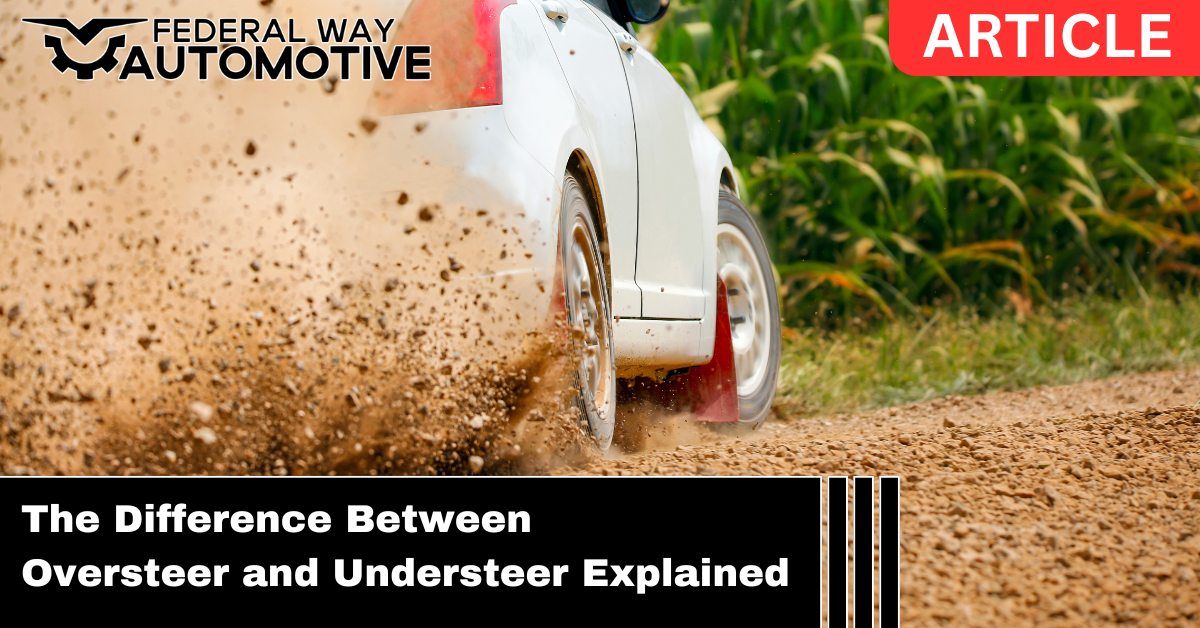You turn the wheel — but your car doesn’t respond the way you expect. Maybe the front slides wide. Maybe the rear swings out. Either way, something feels off.
These handling behaviors are known as understeer and oversteer, and they affect how your car behaves during cornering, especially in slippery or high-speed situations.
At Federal Way Automotive, we help drivers across Federal Way, Tacoma, Fife, Milton, and Edgewood understand how their vehicle’s handling can change depending on the drivetrain, suspension, and even tires. In this post, we’ll break down what oversteer and understeer mean, what causes them, and how you can stay in control.
What Is Understeer?
Understeer happens when the front tires lose grip before the rear tires. As a result, your car continues to travel straight even though you’re turning the wheel. You may feel like the car isn’t turning enough, or that it’s “plowing” through the corner.
Common signs of understeer:
- Front tires squeal during cornering
- You turn the wheel more, but the car keeps going straight
- It feels like the steering is delayed or unresponsive
What causes understeer?
- Excessive speed when entering a corner
- Front tires with low grip or poor alignment
- Heavy front-wheel drive bias
- Power steering problems or overly assisted steering feel
- Wet, icy, or gravel road surfaces
Front-wheel drive vehicles are more prone to understeer because most of the vehicle’s weight (engine, transmission) is over the front wheels. If the tires lose traction, steering becomes less effective.
What Is Oversteer?
Oversteer occurs when the rear tires lose grip before the front tires, causing the back of the car to swing outward. If not corrected quickly, the car may spin out.
Common signs of oversteer:
- Rear of the car feels like it’s stepping out or sliding
- You turn into a corner and the car turns more sharply than expected
- Loss of control if you overcorrect the slide
What causes oversteer?
- Accelerating too hard in a turn
- Lifting off the throttle suddenly in a corner
- Worn rear tires or poor suspension balance
- Rear-wheel drive vehicle layouts
- Icy or slick road surfaces
Rear-wheel drive cars — especially ones with lots of power — are more likely to oversteer when traction is lost at the rear wheels.
What’s Safer — Oversteer or Understeer?
Both can be dangerous, but understeer is generally more manageable for the average driver. The vehicle slows down naturally when you lift off the throttle, and you can regain control by easing off the steering input.
Oversteer, on the other hand, can lead to a complete spinout if you’re not careful — especially in low-traction conditions.
That’s why most modern vehicles are designed with a slight understeer bias — it’s easier to correct and less likely to result in a crash.
How to React to Understeer or Oversteer
If you experience understeer:
- Ease off the throttle
- Straighten the steering wheel slightly
- Allow the front tires to regain grip before steering more
If you experience oversteer:
- Gently steer into the skid (turn the wheel in the direction the rear is sliding)
- Avoid overcorrecting
- Apply throttle carefully if you’re driving a rear-wheel drive vehicle — this can stabilize the car
Driving smoothly — with gentle throttle, brake, and steering inputs — is the best way to prevent both.
Can Power Steering Cause Oversteer or Understeer?
Not directly — but worn or faulty power steering components can exaggerate handling problems. For example:
- A failing power steering rack may reduce steering responsiveness
- Overly boosted steering can lead to abrupt inputs and cause understeer
- Uneven steering effort can make it harder to correct oversteer
At Federal Way Automotive, we check for power steering leaks, pump issues, and steering rack problems as part of any handling or suspension inspection.
When to Have Your Vehicle Checked
If your car is frequently understeering, oversteering, or just feels unstable around corners, it could be a sign of a mechanical issue:
- Uneven tire wear
- Poor alignment
- Worn shocks or struts
- Failing bushings or control arms
- Power steering problems
- Imbalanced tire pressure (yes, this matters!)
These issues can affect traction, balance, and steering response — all of which can exaggerate oversteer or understeer.
Auto Repair and Steering Diagnosis in Federal Way, WA
At Federal Way Automotive, we take vehicle safety seriously. If your car isn’t cornering the way it should — or just doesn’t feel stable on the road — we can inspect your steering, suspension, alignment, and tires to get to the root of the issue.
Whether you drive a front-wheel drive commuter or a rear-wheel drive performance car, we’ll make sure your vehicle handles safely and predictably.
Call us today or schedule your appointment online. Let’s keep your car steering straight and tracking true — no surprises in the corners.


